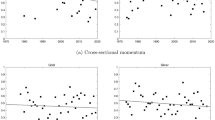Abstract
In this article, we compare a variety of technical trading rules in the context of investing in the S&P500 index. These rules are increasingly popular, both among retail investors and CTAs and similar investment funds. We find that a range of fairly simple rules, including the popular 200-day moving average (MA) trading rule, dominate the long-only, passive investment in the index. In particular, using the latter rule we find that popular stop-loss rules do not add value and that monthly end-of-month investment decision rules are superior to those which trade more frequently: this adds to the growing view that trading can damage your wealth. Finally, we compare the MA rule with a variety of simple fundamental metrics and find the latter far inferior to the technical rules over the last 60 years of investing.
Similar content being viewed by others
Notes
Note that the ‘filter rules’ of Alexander (1961) and Fama and Blume (1966) were of a similar purpose but did not yield superior returns.
Lo et al (2000) provide evidence that algorithms implementing other popular patterns of technical analysis can provide incremental information for returns. Here, we concentrate on strategies that can be given a precise analytic form.
From Shiller’s Website www.econ.yale.edu/~shiller/data.htm.
References
Acar, E. and Satchell, S. (2002) Advanced Trading Rules. 2nd edn. London, UK: Elsevier.
Alexander, S. (1961) Price movements in speculative markets: Trends or random walks. Industrial Management Review 2: 7–26.
Annaert, J., Van Osselaer, S. and Verstraete, B. (2009) Performance evaluation of portfolio insurance using stochastic dominance criteria. Journal of Banking and Finance 33 (2): 272–280.
ap Gwilym, O., Seaton, J., Suddason, K. and Thomas, S. (2006) International evidence on the payout ratio, earnings, dividends, and returns. Financial Analysts Journal 62 (1): 36–53.
ap Gwilym, O., Clare, A., Seaton, J. and Thomas, S. (2010) Price and momentum as robust tactical approaches to global equity investing. Journal of Investing 19 (3): 80–92.
Asness, C., Moskowitz, T. and Pedersen, L. (2009) ‘Value and Momentum Everywhere’, University of Chicago and AQR Capital Management. Working Paper.
Campbell, J. and Shiller, R. (1998) Valuation ratios and the long-run stock market outlook. Journal of Portfolio Management 24 (2): 11–26.
Clare, A., Thomas, S. and Wickens, M. (1994) Is the gilt-equity yield ratio useful for predicting UK stock returns? Economic Journal 104 (2): 303–315.
Conrad, J. and Kaul, G. (1998) An anatomy of trading strategies. Review of Financial Studies 11 (3): 489–519.
Dybvig, P. (1988) Inefficient dynamic portfolio strategies, or how to throw away a million dollars in the stock market. Review of Financial Studies 1 (1): 67–88.
Faber, M. (2007) A quantitative approach to tactical asset allocation. Journal of Wealth Management 4.
Fama, E. and Blume, M. (1966) Filter tests and stock market trading. Journal of Business 39 (1): 226–241.
Gollier, C. (1997) On the inefficiency of bang-bang and stop-loss portfolio strategies. Journal of Risk and Uncertainty 14 (2): 143–154.
Hurst, B., Ooi, Y.H. and Pedersen, L. (2010) ‘Understanding Managed Futures’, AQR. Working Paper.
Hurst, B., Ooi, Y.H. and Pedersen, L. (2012) ‘A Century of Evidence on Trend-Following Investing’, AQR. Working Paper.
Ilmanen, A. (2011) Expected Returns. London, UK: John Wiley & Sons.
Jegadeesh, N. and Titman, S. (2001) Profitability of momentum strategies: An evaluation of alternative explanations. Journal of Finance 54 (2): 699–720.
Kaminski, K. and Lo, A. (2008) ‘When Do Stop-Loss Rules Stop Losses?’, SIFR Research Report Series 63, Institute for Financial Research.
Korajczyk, R. and Sadka, R. (2004) Are momentum profits robust to trading costs? Journal of Finance 59 (3): 1039–1082.
Lei, A.Y. and Li, H. (2009) The value of stop loss strategies. Financial Services Review 18 (1): 23–51.
Lesmond, D., Schill, M. and Zhou, C. (2004) The illusory nature of momentum profits. Journal of Financial Economics 71 (1): 349–380.
Lo, A., Mamaysky, H. and Wang, J. (2000) Foundations of technical analysis: Computational algorithms, statistical inference, and empirical implementation. Journal of Finance 55 (4): 1705–1770.
Miffre, J. and Rallis, G. (2007) Momentum strategies in commodity futures markets. Journal of Banking & Finance 31 (6): 1863–1886.
Moskowitz, T., Ooi, Y.H. and Pedersen, L. (2010) ‘Time Series Momentum’, University of Chicago. Working Paper.
Park, C.H. and Irwin, S. (2005a) ‘The Profitability of Technical Trading Rules in US Futures Markets: A Data Snooping Free Test’, University of Illinois at Urbana-Champaign. Working Paper.
Park, C.H. and Irwin, S. (2005b) ‘A Reality Check on Technical Trading Rule Profits in US Futures Markets’, Conference on Applied Commodity Price Analysis, Forecasting, and Market Risk Management, St. Louis, Missouri.
Rouwenhorst, K. (1998) International momentum strategies. Journal of Finance 53 (1): 267–284.
Szakmary, A., Shen, Q. and Sharma, S. (2010) Trend-following trading strategies in commodity futures: A re-examination. Journal of Banking and Finance 34 (2): 409–426.
Acknowledgements
We are grateful to an anonymous referee and the editor for instructive insights.
Author information
Authors and Affiliations
Corresponding author
Additional information
2has a PhD from Southampton University, UK, and has been a Research Fellow at Cass Business School. He is a Director of Solent Systematic Investment Strategies, a creator of Smart Beta indices and an independent consultant specialising in quantitative portfolio strategies.
Rights and permissions
About this article
Cite this article
Clare, A., Seaton, J., Smith, P. et al. Breaking into the blackbox: Trend following, stop losses and the frequency of trading – The case of the S&P500. J Asset Manag 14, 182–194 (2013). https://doi.org/10.1057/jam.2013.11
Received:
Revised:
Published:
Issue Date:
DOI: https://doi.org/10.1057/jam.2013.11




